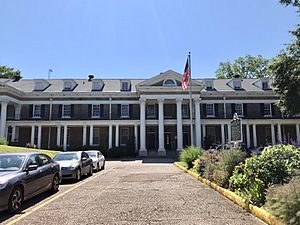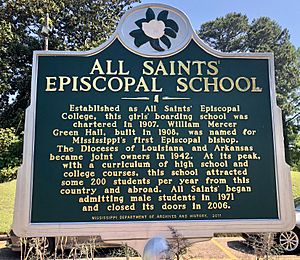All Saints' College (Vicksburg) facts for kids
All Saints' Episcopal College was an Episcopal college for women in Vicksburg, Mississippi. It started in 1908 and closed in 2006. In 1971, it began accepting male students and became All Saints' Episcopal School.
All Saints' Episcopal College was planned for many years before it opened in 1908. Its beginnings came from the work of the first Bishop of Mississippi, William Mercer Green. He became Bishop in 1850 and served until 1887.
The College of St Andrew was one of the first church schools in Jackson, started in 1852. This was long before public schools were common. The Civil War stopped plans for a girls' school. However, other church schools were created, including schools for African American students.
In 1903, Theodore DuBose Bratton became the Bishop of Mississippi. Bishop Bratton wanted to create All Saints' because he believed in Christian education. He also wanted to finish the work that Bishop Green had started.
Contents
History of All Saints'
The School's Name
The school had a few different names when it started. Records of the land sale called it the "Episcopal Diocese Girls College." A newspaper article called it "All Saints' Episcopal College." Another paper called it "All Saints' College for Girls."
The church group provided a loan of $50,000 to help start the school. The city of Vicksburg also gave the school 25 acres of land and $32,500.
William Mercer Green Hall
The main building was named William Mercer Green Hall. It was named after Mississippi's first Episcopal bishop. The first stone was laid on All Saints' Day in 1908. This building was designed by architects from New Orleans. It was built for $62,175.
The building was made of brick and concrete with a steel frame. It was 230 feet long and 40 feet wide. The final cost was $80,000. It had dorm rooms for 50 students. It also had a kitchen, dining room, and offices. There were music rooms, a library, and an infirmary for sick students. Art studios had special skylights. The school grounds also had gardens for fresh vegetables. They even had cows for fresh milk.
Important Moments
First School Year: 1909 - 1910
The Rev. William Mercer Green Jr. was the first Dean of the college. He was the grandson of the first bishop. The school's catalog from 1909 explained its goals.
The high school followed standards set by a group of colleges. Students needed 14 units (credits) to graduate from high school. All Saints' was a Junior College. This meant it offered the first three years of a standard college education. Graduates received a certificate, not a degree.
Here were some of the yearly costs:
| Tuition, board, heat, light, laundry | $265–275.00 |
| Medical fee (for students living at school) | 10.00 |
| Other fees | 5.00 |
| Day students (college) | 75.00 |
| Day students (high school) | 60.00 |
| Day students (preparatory) | 50.00 |
Students could study science, math, and English. They could also take four years of Latin. Other language courses included Greek, French, Spanish, and German. College courses covered many subjects. These included math, history, English, science, and several languages. The school year had two terms, each 18 weeks long.
Students had daily services in the campus chapel. On Sundays, they could attend services at any local church. A chaperone always went with them.
1910 - 1911
Two intermediate years (grades) were added to the school. Father Green left All Saints' to work at another church.
1911 - 1912
Many well-known colleges spoke highly of students from All Saints' high school. These included Wellesley, Smith, and Vassar. The high school was approved by the University of Mississippi this year. All college credits were accepted. A business course was added. It taught typing, shorthand, and bookkeeping. One more grade was added to the intermediate years. The school now taught grades 6 through 12, plus college courses.
1912 - 1913
Baseball was added to the sports program. The school wrote to its supporters. It mentioned needing more classrooms, an indoor gym, and a chapel.
1913 - 1914
A long-distance phone connection was added. This allowed students and parents to communicate better.
The school only admitted white women for many years. The Episcopal Church officially supported ending segregation. This happened after the Brown v. Board of Education court case. However, All Saints' remained segregated for a while.
In 1925, construction began on a new dorm. It was named Johnson Hall. This was in honor of Mrs. J. W. Johnson, who donated money for it. A new tradition also began. The intramural basketball team was split into two groups. They were called The Swamp Angels and the Knockouts. Later, the teams became the Angels and the Devils. These teams would divide all students for competitions.
In 1942, Father Christian suggested that All Saints' should belong to three states. These were Mississippi, Louisiana, and Arkansas. The school's board of trustees was changed. It now included members from all three areas.
The first male students who lived at the school were accepted in the 1971–72 school year. The first boys to graduate were in the Class of 1972. There were five boarding students and one day student.
Charlene Eichelberger, known as "Miss Ike," was hired in 1968. She led the Recreation Department. She stayed at the school until 1992. She returned briefly in 2006–2007. She helped clean the campus before AmeriCorps used part of it. Miss Ike helped All Saints' gain national recognition for its recreation program. She lived on campus during her time there.
Father Dickson's son, Charlie, also worked at the school for many years. His wife, Cassie, worked there too. They stayed until the school closed in 2006. Charlie could not attend All Saints' himself. It was an all-girls school when his father became Headmaster in 1968.
The school used a "Level System" from 1969 to 2002. Students had Levels 1-5, which decided their privileges. In 2002, an Honor Code was introduced instead. Also in 2002, the campus became smoke-free. The school used a trimester system (three terms per year) from 1969 to 2006.
In 2003, the board decided to close the school. However, temporary funding and strong support from former students saved it. The school finally closed permanently in 2006.
Today, the campus is leased by AmeriCorps. But it is still owned by the church groups from 1942. Some church employees live on campus. They help with the upkeep of the buildings and grounds.
Leadership
| 1909 - 1911 | The Rev. William Mercer Green Jr., Dean |
| 1911 - 1912 | Dr. Thomas Pearce Bailey, Dean |
| 1912 - 1937 | The Rt. Rev. Theodore DuBose Bratton, President |
| 1937 - 1958 | The Rev. William Gerow Christian, Rector |
| 1958 - 1961 | The Rev. John Maury Allin, Rector |
| 1962 - 1967 | The Rev. John Stone Jenkins, Rector |
| 1967 - 1968 | The Rev. A Dean Calcote, Acting Rector |
| 1968 - 1983 | The Rev. Alex Dickson Jr., Rector and Headmaster |
| 1983 - 1999 | The Rev. David Luckett, Rector and Headmaster |
| 2000 - 2001 | Charles Craft, Interim Head |
| 2001 - 2006 | The Rev. Martin, Rector and Head |



